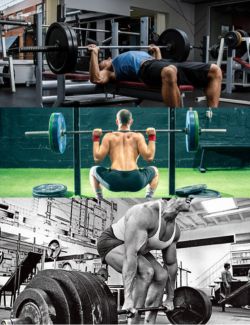When it comes to building a well-rounded and effective workout program, few exercises can rival the importance of the “Big Three”: bench presses, deadlifts, and squats. These compound movements are not only revered by powerlifters and bodybuilders but are also essential for anyone looking to achieve their fitness goals efficiently and safely. In this blog, we will explore why the Big Three exercises are vital to a great workout program and how they serve as an excellent starting point for beginners.
1. Bench Press: Powering Up Your Upper Body
The bench press is the quintessential upper-body exercise that primarily targets the chest, shoulders, and triceps. It involves lying flat on a bench and pushing a barbell upward, engaging multiple muscle groups simultaneously. This compound movement not only helps you gain strength and muscle mass but also improves overall upper-body stability and core strength.
One of the main reasons the bench press is considered a cornerstone of any workout routine is its versatility. Whether you’re an athlete looking to enhance your performance or a fitness enthusiast aiming to build a strong and aesthetic upper body, the bench press can be tailored to suit your goals. It is also a great indicator of upper body strength and progress, making it an essential lift for tracking improvements over time.
2. Deadlifts: Unleashing Your Full Potential
The deadlift is a powerhouse exercise that targets the posterior chain, including the lower back, glutes, hamstrings, and grip strength. It involves lifting a loaded barbell from the ground to a standing position, engaging multiple muscle groups in a coordinated effort. Deadlifts are unparalleled in their ability to develop overall strength, build muscle, and improve functional fitness.
Besides its physical benefits, the deadlift teaches us a valuable lesson about proper form and safety. It reinforces the importance of maintaining a neutral spine and engaging the core, reducing the risk of injury during other exercises and daily activities. Additionally, deadlifts boost your metabolism, making them a fantastic tool for burning calories and promoting fat loss.
3. Squats: Building a Solid Foundation
Squats are the king of lower body exercises, targeting the quadriceps, hamstrings, glutes, and core. They are fundamental for functional movement and are essential for activities like walking, climbing stairs, and playing sports. Squats build lower body strength, increase flexibility, and promote better balance and stability.
As with the other Big Three exercises, squats require proper form and technique to avoid injuries. Focusing on maintaining a neutral spine, engaging the core, and using the correct depth will not only protect your joints but also maximize the benefits of the exercise. Squats are a gateway to many other lower body exercises, making them a crucial building block for an effective workout program.
Why the Big Three Are Ideal for Beginners
For beginners, the Big Three exercises are an ideal starting point for several reasons:
- 1. Efficiency. These compound movements engage multiple muscle groups simultaneously, making your workouts more time-efficient. You can achieve significant results with a shorter training session compared to performing isolated exercises.
- 2. Progressive Overload. The Big Three exercises are easily adaptable to progressive overload, where you gradually increase resistance to challenge your muscles. This is crucial for continuous growth and improvement.
- 3. Real-life Application. These exercises mimic functional movements that we perform in our daily lives, making them highly practical and beneficial for overall fitness and health.
Safety and Ego Lifting
While the Big Three exercises are immensely beneficial, safety should always be the primary concern. Here are some essential tips for practicing these exercises safely:
1. Proper Form: Learn and master the correct form for each exercise before adding heavy weights. Performing the movements with improper technique can lead to injuries.
2. Start Light: Begin with light weights to allow your body to adapt to the movements and reduce the risk of strain or injury.
3. Warm-up: Always warm up before lifting heavy weights to prepare your muscles, joints, and nervous system for the workout.
4. Progress Gradually: Gradually increase the weight and intensity of your workouts over time. Avoid ego lifting, where you prioritize lifting heavy weights over maintaining proper form.
5. Listen to Your Body: Pay attention to your body’s signals. If something feels off or painful, stop immediately and seek professional advice if needed.
In conclusion, the Big Three exercises, including the bench press, deadlifts, and squats, are essential components of a great workout program for individuals of all fitness levels. These compound movements efficiently target multiple muscle groups, help build strength and muscle mass, and enhance functional fitness. For beginners, mastering the Big Three provides a solid foundation for continuous progress and paves the way for more advanced exercises. Always prioritize safety over ego lifting, and remember that proper form and gradual progression are key to long-term success in your fitness journey.




